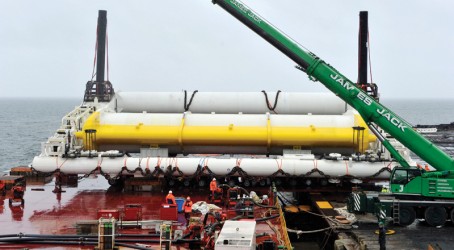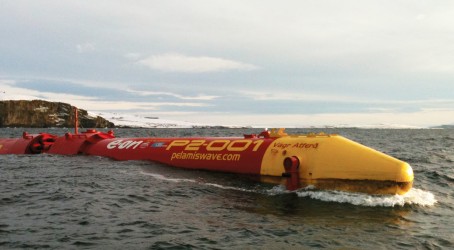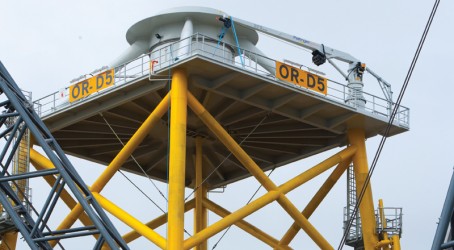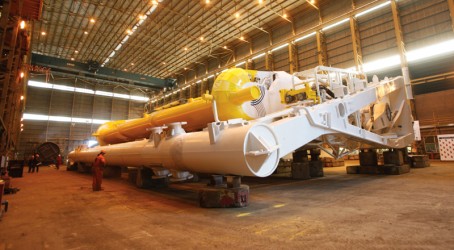Commentators on renewable energy matters have long predicted that the expertise and infrastructure accrued by the UK’s oil and gas industries will naturally go towards boosting fledgling green technologies. The skills and experience built up over decades of working out at sea would help burgeoning offshore wind, tidal and marine generators become serious players, so the theory goes, and could even, once the oil has dried up, maintain a healthy income for Scotland.
Whether the green sector will ever reach those heights is at least a generation away but there are moves within the oil and gas industry that point towards this so-called green revolution getting under way.
With encouraging progress being made in building offshore wind turbines in UK waters and a host of other marine devices going into production, the renewables sector is certainly growing, particularly in Scotland, and is turning to its counterparts in oil and gas for help in spurring further growth.
Gordon Edge, director of policy at RenewableUK, the trade association for wind and marine energy, says that, although renewables have been planned for many years, the industry building them is still in its infancy. “This is about starting a new industry from scratch,” says Edge, adding a reminder that when oil was found in the North Sea, drilling expertise was borrowed from abroad. “But it will happen in the next 10 years, for offshore wind certainly. Wave and tidal sources will be developed further and we’ll see new devices by the 2020s.”
Offshore wind is the energy source the others have to catch up with. According to European Wind Energy Association figures, the UK is way ahead of the rest of Europe, thanks to work under way on seven offshore sites between January and June this year. This saw 108 tower foundations built, 101 turbines installed and 245MW of capacity connected to the grid. When finished, the seven sites will have a capacity of 2,238MW. Just four offshore sites were worked on across the rest of Europe, and they will be able to generate 606MW.
In terms of keeping the capital earned by that industry in the UK, progress seems more mixed. There is currently no major turbine manufacturer operating in the UK (although that could change, with the likes of Siemens and turbine maker Vestas said to be keen to establish a factory in Britain soon). But where there is the potential to earn is in the construction process. From seabed surveys to construction of underwater foundations, the companies now servicing offshore turbines cut their teeth in the oil and gas industry.


Edge singles out the Ormonde windfarm 10km off the coast of Barrow-in-Furness as a case in point. Construction began in May 2010 and the first of 30 5MW turbines was lifted into place in April this year. The last turbine was put up in mid-August and commissioning for all of them is under way, with completion expected at the end of the year.
The four-legged lattice towers, or jackets as they’re known in the offshore environment, on which the more familiar tubular supports and nacelles sit, were built by Burntisland Fabrications (BiFab), of Burntisland, Fife. Formed in 2001 following a management buy-out, BiFab claims it has been Scotland’s only major fabricator serving the wind industry since 2005.
Managing director John Robertson says BiFab’s skills in delivering similar structures for the oil and gas industry make it a natural choice for windfarm developers. “We have a proven product with a track record of delivering for industry. The structures adopted for the oil and gas industry were designed very robustly and many of them have been out there for 20 to 25 years,” says Robertson. He says the patented jacket design is not only reliable but lightweight too, which helps reduce installation costs.
Another name associated with heavy industry has been involved with Ormonde too. Harland and Wolff, the historic Belfast shipyard, provided logistic support for the project, assembling blades, rotor hubs and nacelles before sending them out to sea.
Given the expected growth in offshore wind – Edge reckons there will be about 1,000MW a year coming online in the next five years – BiFab has invested in two sites so it will be able to make 150 jackets a year from 2013, up from its current 60 a year. This is largely thanks to a £28 million investment programme that began in April 2010 when 15% of the company was sold to energy provider Scottish and Southern Electricity (SSE).
Part of the deal is that BiFab will meet SSE’s predicted needs for offshore turbines, which will be “50 jacket substructures a year for 12 years from 2015. That’s the minimum so that may leave capacity to make another 100 a year,” says Robertson. He hopes demand from the oil and gas industry and offshore developers in other European countries will help fill the gap between 2013 and 2015.
BiFab has also provided the steelwork for the latest version of the Oyster wave-powered generator, designed by Aquamarine Power. Launched in July, the 800kW device was sent off for trials at the European Marine Energy Centre in Orkney in mid-August. Another pair of Oysters, with increased capacity, is intended to be deployed in 2012 and 2013, with the intention of creating a 2.4MW onshore hydro-electric plant.


Another renewable company that has benefited through exploiting the skills base that expanded in Scotland thanks to the oil and gas industry is Pelamis Wave Power, developer of the Pelamis wave-energy converter, which has been designed and built at its headquarters in Leith Docks, Edinburgh. The huge floating “sea snakes” are made of steel tubes joined by hinges, each of which flexes in relation to its neighbour and creates motion that drives generating sets on board.
“We definitely, as a company, very much benefit from being in Scotland and having access to the oil and gas infrastructure and skills base. The crossover can be seen in the manufacturing skills, such as our very skilled coded welders, technicians and fitters,” says Ros Hart, project development engineer at Pelamis.
She adds that having access to the very versatile boats used by oil and gas firms also helped when towing out to sea one of the firm’s products, the latest of which weighs 1,300 tonnes and is 180m long. Ports and harbour facilities are very good for the same reasons, says Hart.
“There is a whole raft of standards for offshore operations like towing and guidance on working at sea and all the things you need for running oil and gas platforms. Having people qualified to plan operations to move and install a heavy device like ours, and even to work on deck, is invaluable,” says Hart.
She says the company also benefited from working to exacting oil and gas standards which not only helped with designability of equipment but also in securing insurance. “From the outset we went to the trouble of having designs independently verified, by engineering group Atkins. They verified to existing oil and gas standards, which was a process we felt customers would want.”
While there is no doubt both sectors have plenty in common, Edge at RenewableUK points out an issue that will have to be overcome, centred on the quantity of products required. He says: “We’re talking about making hundreds of turbines, rather than a handful of platforms. So you go from bespoke, high-end engineering to knocking them out by the dozen. That focus is very different.”
The older sector’s approach has led people in renewables to call their quotations for work, which can be 10 times the cost available elsewhere, “the oil and gas price,” using that as a byword for overpriced. Edge suggests that the oil and gas sector getting used to manufacturing in bulk will help create economies of scale that will help it become more competitive.
It’s a Scottish thing…
The Scottish National Party (SNP), which won May’s election, has made renewables a priority, setting a goal of Scotland becoming more than self-sufficient in electricity by 2020. The SNP manifesto stated that renewables would generate “more than 100% of Scotland’s likely consumption”. This has translated into an industry target of 10GW by 2020.
Ros Hart from Pelamis says support for renewables is apolitical. “The SNP is leading the way but it’s got cross-party support in Scotland. There’s recognition this is a chance to build an industry here. The public recognise the opportunity and are keen to have renewables and to have manufacturing industry grow from it,” says Hart.
Scottish Liberal Democrat leader Willie Rennie says the presence of an oil and gas sector, which has at least 2,000 companies in its supply chain, is an advantage for renewables companies. “Around 40% of the cost of a windfarm is offshore activity so that’s installation, cable laying, jacket construction and maintenance. A lot of those businesses are in place. Even businesses transporting people, to and from offshore sites and, looking into the long term, there’s experience in decommissioning here too,” he says.